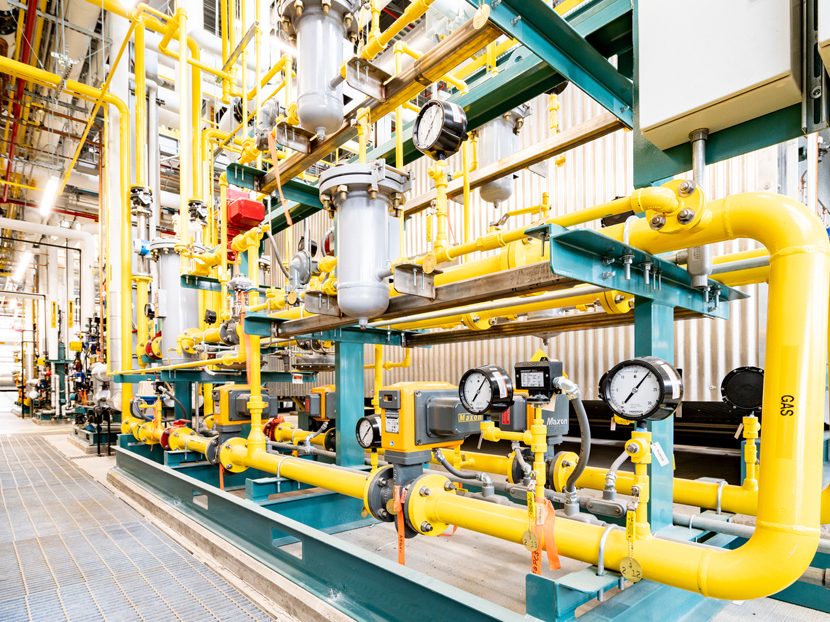Plumbing and Mechanical Coordination
Great engineers can coordinate systems with other disciplines on the team.

Building systems design is the culmination of thousands of questions, decisions and conversations amongst the design team typically revolve around the coordination of systems demands. The difference between good engineers and great ones is their ability to coordinate systems with the other disciplines on the team, which is a necessary requirement for every project.
In particular, plumbing and mechanical coordination is typically a result of the mechanical needs within a building and mostly dictated by the maintenance and serviceability needs required of the system. This column will review some of the typical plumbing and mechanical coordination items we have experienced in our careers to help you with your next project.
Makeup Water
Makeup water is nonpotable water provided for HVAC applications connected to the domestic water system, which requires a backflow preventer to protect the domestic water system. The type of backflow preventer will be determined by the risk category and the kind of connection to the system, so consult your local plumbing code and the published ASSE standards.
For the plumbing engineer to properly select and size a backflow preventer, the following items are required from the mechanical engineer: the flow rate, usage for the makeup water and pipe size. The flow rate is the obvious item necessary for equipment and pipe sizing. Still, in addition to the actual flow rate, it is essential for the plumbing engineer to understand the function of the makeup water as well as the frequency of use.
For example, closed-loop HVAC systems such as hot water and chilled water systems are typically filled using the domestic water system and are then used infrequently after installation. After building occupancy, a typical use would include maintenance needs such as draining or replacement of equipment in the system that would require the refilling of a section of the closed-loop piping system.
Other systems, such as open-loop cooling tower systems, will require continuous makeup during the operation of the system due to the loss of water from evaporation, blowdown and drift. Finally, with the flow rate and usage known, the appropriate pipe size can be provided by the plumbing engineer for connection by the mechanical contractor.
The transition point between trades typically consists of a capped connection downstream of the backflow preventer provided by the plumbing contractor where the mechanical contractor continues the nonpotable water.
The other coordination item related to makeup water would include other systems such as steam boilers or humidification systems, where there may be a water quality component requirement for the mechanical device to operate correctly. The mechanical engineer and plumbing engineer must coordinate on this early on in the project, especially if there is a need for water treatment solutions, which will take up space in the mechanical room.
Floor, Hub Drains
Potentially the largest coordination item between the mechanical and plumbing disciplines is the requirement for drains. There are two types of drains commonly used and requested by the mechanical engineer, in addition to two functions the drains provide from a plumbing standpoint.
Because of this, the mechanical engineer must be clear and deliberate on what is being discharged to the drain system so the plumbing engineer can design the drainage system correctly, but also so the piping can handle the discharge from the mechanical equipment.
The first need from the mechanical standpoint is the requirement for floor drains. Floor drains are typically located within mechanical rooms near the significant pieces of equipment such as pumps, chillers, boilers and heat exchangers.
The need for the floor drains is purely a maintenance and convenience requirement for when equipment is serviced and water is removed from the equipment and splashes on the floor. Floor drains by nature are discharged to the sanitary sewer system as the water is considered dirty water that must be treated by the municipal sewer system.
The second need for drainage is hub drains, whereas the requirements for hub drains are slightly more complicated. The most common location for them are at cooling coils where the air is cooled and dehumidified by the mechanical equipment. Regardless of mechanical system selection, as a result of the cooling process, moisture is removed from the airstream and must be disposed of.
This water is clean and reusable and may be discharged to the storm sewer system or to alternative locations with some slightly less stringent requirements. Depending on the system used by the mechanical engineer, this could be a hub drain located adjacent to large air-handling units that are predictable in regards to their location.
Or it could be a distributed system, such as a fan coil unit or heat pump system, that has many cooling coils spread throughout the building. In that case, there is typically a more robust cooling coil condensate drainage system designed by the mechanical engineer that is routed to precise locations within the building for discharge to the plumbing system.
Additionally, there are applications where this water could be used as makeup water for cooling tower applications or other reuse systems. Rooftop units do not require hub drains since the condensate discharges onto the roof and drains to the storm sewer system used for rainwater. This should be verified with the local plumbing code.
In addition to clearwater hub drains, there also are applications for hub drains that must be discharged to the sanitary sewer systems. These applications are typically specific to a dedicated function within the building and are located within the mechanical room, including cooling tower blowdown, chemical treatment drains and boiler blowdown.
The drain for these systems will look and act the same as the clearwater drains discussed for cooling coils, but are connected to the sanitary sewer system and require a little more coordination due to the potential for larger flow rates, chemical removal or high-temperature fluids. Because of this, the mechanical engineer should identify the required locations of the drains, as well as the function of the drain.
For example, a steam boiler blowdown drain will have different requirements than a cooling tower blowdown drain. The former has high-temperature water that must be cooled before discharge to the plumbing system and may dictate a specific pipe material due to the temperatures. Additionally, the increased use of condensing boilers requires acid neutralization by the mechanical engineer, but should this system fail, the plumbing engineer may want to evaluate the use of alternative piping materials for added protection in the system.
In all cases, the benefit to utilizing a hub drain is that the discharge is more localized and contained in lieu of discharging directly to the floor and creating a potential hazard.
Other drain solutions your team should have in their toolbox are floor sinks and trench drains. These drain solutions can be beneficial in scenarios where a lot of water must be discharged and there also is a need for maintenance drainage in the area.
Hose Bibbs, Roof Hydrants
Makeup water and drains are commonly identifiable items with the plumbing system. Still, another item that should be provided by the plumbing engineer with the direction of the mechanical engineer for use by the facility staff is hose bibbs within select mechanical rooms.
It would be recommended to spot a hose bibb in each mechanical room so it is centrally located and can be used to clean the floor or equipment in the case of spills or leaks. As with the mechanical makeup water, the plumbing engineer should consult the plumbing code on what the proper backflow prevention might be.
Similarly, equipment located on the roof or outside on grade also deserves hose bibbs or roof hydrants, which can be used to clean equipment, such as the cooling tower fill or air-cooled condensing unit coils from dirt and debris due to operating in the open atmosphere.
Location of the hose bibbs and roof hydrants should be coordinated carefully with the mechanical engineer, so the water connection is easily provided for the facility staff to connect and access the equipment. This requires cleaning without the need for carrying long hoses throughout the facility.
Chemical Treatment Equipment
Outside of the standard fixtures used with mechanical coordination, there are potential conditions where the mechanical engineer may request an emergency shower or sink for conditions where the maintenance staff uses chemicals.
All closed-loop HVAC systems and open-loop condenser water systems require chemicals to maintain conductivity, pH and reduce biological growth. Still, depending on the system, it would be recommended to provide at a minimum a sink for chemical treatment equipment and testing within the mechanical room.
On larger chilled water systems with cooling towers or large steam systems, it would be recommended to provide an eyewash or emergency shower as a safety measure in case facility personnel get chemicals on themselves.
Natural Gas
Natural gas coordination is a unique condition and we have seen situations where the natural gas piping design has fallen to both disciplines, depending on the building needs. Generally, the discipline with the largest gas load ends up with the design of the natural gas piping system, so both engineers must be able to size the piping based on available pressure and loads within the building.
Regardless of who completes the system design, both parties should reach out to discuss items of importance such as available gas pressure, gas system loads, system pressure drop, maximum and minimum operating pressure of the appliance, and where valved and capped connections will be provided for the other engineer to connect for his system design.
Coordination Process
To coordinate this, it is our opinion that mechanical engineers should initiate this process because the majority of the needs are mechanical and based on their equipment and system selection. Then, plumbing engineers can integrate the system requirements into the design of their systems.
First, a memo from the mechanical engineer to the plumbing engineer should outline the requirements of the system, including drain types, locations, flow rates, pipe sizes, etc. Additionally, a marked-up plan should accompany the memo identifying the location of the equipment so the plumbing engineer can observe the design intent of the mechanical engineer and know what obstructions or locations are critical to spot the items correctly on the plans.
Second, and potentially the most critical item, is a verbal discussion with each other on what is required. This simple conversation can help alleviate a lot of potential issues before significant costs are incurred to make changes.
This column provides a brief introduction into the basics of plumbing and mechanical coordination that should occur on every project. Each project will have its own requirements and needs based on the mechanical system selection and should be communicated between the mechanical and plumbing engineers.





